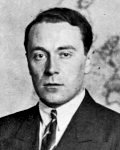
|
René Couzinet was born in 1904 in La Roche-sur-Yon, in France. As a child, he was already fascinated by the question of the heavier-than-the-air flight, observing the birds flight, particularly swallows, who would inspire him later in designing the shape of his first planes.
In October 1921, he entered l'Ecole des Arts et Métiers, the technical school in Angers. The following year, the 18-year-old claimed several patents in the field of aviation, including one about a “plane-helicopter”. He came out second of his class in July 1924 and continued his studies at the Ecole Supérieure d'Aéronautique, the higher school of aeronautics in Rangueuil close to Toulouse, created by colonel Roche and known later as “Sup Aéro”.
In November 1925, he was enlisted in the French Air Force and comes out as a second lieutenant, at the 3rd air regiment based in Le Bourget near Paris.
On May 21, 1927, René Couzinet was among the crowd that cheered Charles Lindbergh who had just successfully flown from New York to Paris. Enthusiastic, he started his project for a three-engine transatlantic commercial aircraft, obtained the necessary funding, and began construction three weeks later.
The result, Couzinet 10, already named L'Arc-in-Ciel, (“Rainbow”) is shown to the press. Its rudder elegantly drowned in the continuity of the fuselage gave it an attractive and previously unseen silhouette, which he said was inspired by swallows, and Press people were bewildered. It wass one of the first monoplane with thick wings, a four-seater, and its three 180HP Hispano-Suiza 8Ac were accessible and reparable in flight. The wheels were ducted. The operating range is over-estimated at 10.000 km, it was able to store 6500 liters of gasoline, maximum speed was 250 km/h, the ceiling was 6.000 meters. It weighed 9300 kg in load, the wingspan was 27 meters, the length 15 meters, the height 3.90 meters, wing surface of 92.75 square meters. It was built out of wood covered with plywood. Its first flight took place on May 7, 1928, only one specimen will be built, and converted into Couzinet 27 in July 1928.

|
Above: Couzinet 10, the first “Arc-en-Ciel”.
The press receives the plane enthusiastically. The pure lines of the craft, the absence of masts and strings still widely used on other planes, often still biplane, were enough to convince that Couzinet must have been thinking ahead.
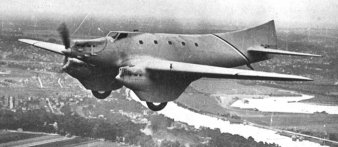
|
Above: Couzinet 10, changed into a Couzinet 11.
But it is too heavy for the official standards: its wing load is 100 kilos per square meter of aerofoil whereas the standard is 50 kilos. Thus it does not get the authorization to fly. The first tests flights are performed despite the ban, and seemed satisfactory all the same, but a too risky maneuver ends in a crash on August 8, 1927, resulting in the death of two of the four occupants, pilot Maurice Drouhin and mechanic André Lanet.
The official standards, sometimes later criticized as stupid, even malevolent, obstacles invented by officials to prevent brilliant visionaries and geniuses to change aviation history, were perhaps not so silly after all...
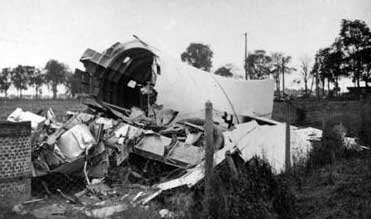
|
A new Arc-en-Ciel must thus be built. The oversized ego and difficult personality of Couzinet clash with the other aeronautical engineers and manufacturers, he refuses any advice, and he is permanently in conflict with the air administrations.
René Couzinet loses support and funding, but the city of Biarritz takes the initiative to call for money for him, and it worked out fine. Couzinet would remember this by calling “Biarritz” one of his planes to come.

|
Above: in flight.
In February 1930, at the workshops that the industrialist Emile-Louis Letord lent him in Meudon in the Hauts-de-Seine, Couzinet builds his second Arc-En-Ciel, as well as an hydroplane, but on February 17, when the plane is ready, a fire destroyed everything. He receives new funding, settles in the island of la Jatte in Levallois-Perret, built a third Arc-En-Ciel, a postal Couzinet 20, or 21, three-engine like the previous one, but three-seater and fitted with three Walter “Vega I” 85 HP engines, then a Couzinet 33, called Biarritz, comes out of the factory on October 6, 1931.
It has a 16 meters wingspan, a 11,73 meters length, a 2,75 meters height, an airfoil surface of 34.40 square meters. It is a four-seater, of a loaded mass of 3500 kg, its engines are three 120 HP De Havilland “Gipsy III” which give it a maximum speed of 260 km/h. The range is of 4500 km.
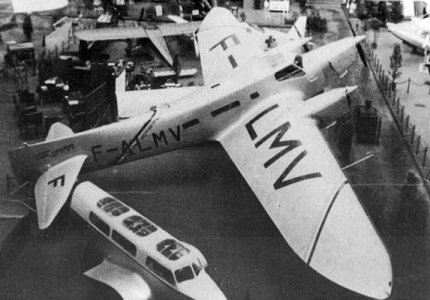
|
Above: Couzinet 33 “Biarritz”.
The “Biarritz” makes a success of the first aerial link from France to New Caledonia, taking off Le Bourget on March 6, 1932, with baron Charles de Verneilh as pilot, the navigator Max Devé and mechanic Emile Munsch. After many stopovers, it lands in New-Caledonia on on April 5, 1932, welcomed by a crowd of 10 000 enthusiasts, but it is destroyed at landing. A second Couzinet 33 “Biarritz” will be rebuilt using its remainders. Aboard, Charles Verneilh flew for example an Algiers-Paris without stop. It then crashed in the fog in Blaisy-Bas in the Côte-d'Or, France, on October 30, 1933.
At the beginning of 1932, an “Arc-En-Ciel III”, aka Couzinet 70, largely improved, comes out of the factory. Its engines develop 650 HP each, the operating range is 11.000 km and the maximum speed is 285 km/h. It makes its first flight on February 11, 1932. One only is built.
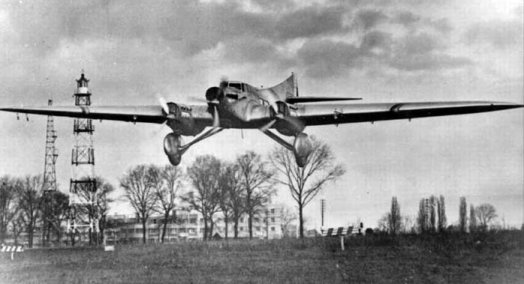
|
Above: Couzinet 70.
The plane interests the Aéropostale, the French Air-mail company, for an airline towards the Southern Atlantic, hitherto impracticable for the planes. The Aéropostale hesitated between the airship, the seaplane, and finally chooses the Arc-En-Ciel. Aéropostale sets up a meeting between René Couzinet and their highly skilled pilot Jean Mermoz, and the two men quickly grow a lasting friendship.
Mermoz flew an “Arc-En-Ciel III” from Saint-Louis-du-Sénégal to Natal in 14 hours and 27 minutes in January 1933.
Then, Mermoz is in charge to carry out an exploit: to fly the “Arc-En-Ciel” from Paris to Buenos-Aires in Argentina for a first attempt at crossing of the Southern Atlantic by a plane instead of a a seaplane. The plane takes off at Le Bourget on 7 January 1933, makes a stopover in Istres, in Port-Etienne in Mauritania, in Saint-Louis-du-Sénégal then crosses the 3173 km above the Atlantic in 14:32 and at an average speed of 227 km/h. It lands in Natal in Brazil, then in Rio, Buenos-Aires, and Montevideo under crowds' applause. Mermoz and Couzinet are cheered, Couzinet is presented in the news media and magazines as an exceptionally gifted genius.
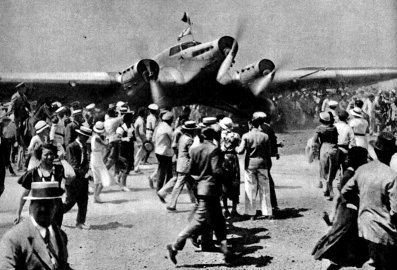
|
Above: Landing in Buenos Aires, Argentina.
The return on May 15 will be hectic, with a coolant circuit fault that forced to stop an engine, but on May 21, 1933, the plane lands in Le Bourget, welcomed by 15 000 enthusiasts. The double crossing of the Southern Atlantic by a plane instead of a seaplane was successful for the first time, and the exploit makes the Air Ministry admit for the first time the seaplane, favored up to now for reasons of safety in sea flight, is not the only acceptable solution any more.
Aéropostale is rocked by financial turmoil, which excites competitors' appetite, it is forced-sold, and absorbed by the new national company Air France. The Arc-En-Ciel III aka Couzinet 70, becomes Couzinet 71 after modifications, it is then sold to Air France and makes a few more South Atlantic crossings in 1934, but no other is ordered. Having expected orders by Air France in vain, Couzinet must shut down his factory at the end of the year.
At Air France, the plane is modified, the Couzinet signature is erased, and as it is already worn out by its perilous flights and ceaseless modifications, it is declared good to burn after only some tests. Couzinet buys it back, without its engines in 1937, but unfortunately it will be destroyed in a fire in 1940.
A “Couzinet 80” which was an RC30 whose central engine was to be replaced by a machine gunner seat is envisaged, a prototype make a first flight on October 3, 1933 and is then abandoned. The “Couzinet 90”, a 2600 HP heavy bomber, ordered by the Air Ministry in 1932, is countermanded in 1934 before construction is finished. Three “Couzinet 73”, 2640 HP three-engine airmail planes ordered in 1934 by the Air Ministry, have their order cancelled in 1935 before being entirely built.
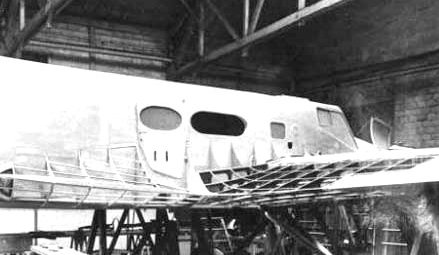
|
Above: Under construction.
Couzinet fights back, prepares new projects in a hangar at Le Bourget, but without sufficient means. His friend and helper Mermoz dies in a plane crash on December 7, 1936. That year, Couzinet registers his new company Société Anonyme Avions René Couzinet, builds the Couzinet 100 three-seater private plane of 13 meters wingspan, which he uses for his own needs, then the quite similar Couzinet 101, reportedly bought by the Spanish Republicans and never seen again since, and the Couzinet 103, improvement of the previous and also as a unique exemplary.
Then comes a Couzinet 150 project: a single-engine speedplane, never built, an “Air Couzinet 10” , his last model to be flown, an “Air Couzinet 246” never built as the order is cancelled. The advance of the manufacturer fades: his wooden planes do not hold comparison any more with the French and US news metal-built planes.
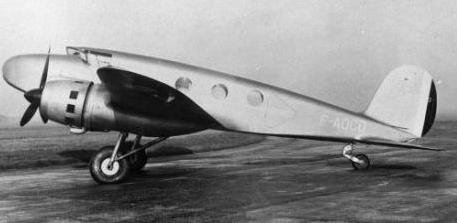
|
Above: Air Couzinet 10.
In 1937, he starts the “Transoceanic” company, supposed to fly his twin-engine Air Couzinet 10.
In 1938, as he gets to repair army Potez bombers he makes some money again. The Minister for Defense allows him to move part of his workshops in La Roche-sur-Yon and he buys ground on the nearby Noirmoutier island where seaplanes can be tested.
At the beginning of 1939, he revises 12 Potez and six Caudron per month, and concludes a compromise with the Air Ministry which puts an end to all the litigations accumulated since years. All the arbitrarily suspended orders get him 5 800 000 francs allowance and he can resume work. He finally obtains a new official order for a model “Air Couzinet 20 B4”, a four-engine bomber plane with a goal to reach a 510 km/h speed. But war is declared, the new factory in Barbâtre in the Noirmoutier island cannot be completed and the two “Air Couzinet 20 B4” prototypes are destroyed in the war before being completed.
His workshop of La Roche-sur-Yon is ordered to manufacture the new fighter plane Vernisse and Galtier VG33, but too late, also.
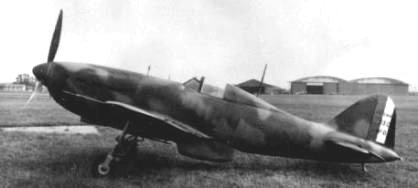
|
Above: VG 33 fighter plane.
Couzinet retreats in the south of France, and on September 20, 1940, leaves for Brazil where he had signed, thanks to President Gétulio Vargas, a 15 years building contract, and he takes the direction of the technical services of the National Plane Factory of Brazil in Lagoa Santa. 35 people of the company join him there. He ends this contract in 1942, volunteers in the Free French Army in September 1943. His always is filled with ambitious projects, such as a 54 tons transatlantic seaplane. He self-publishes his book “Quelques leçons d'aéromécanique: et un règlement d'essais de qualités de vol”.
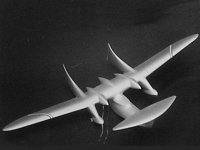
|
Above: A model for a transatlantic project of seaplane of 54 tons by Couzinet.
He returns to France as soon as possible. In 1945, he had to fight to get his Levallois-Perret factory back, but it remains allotted to the SIPA company which the Germans had set up there, and which benefits orders from the Air Ministry. He then starts to repair his La Roche-sur-Yon workshops, whose main building was destroyed by bombs. He wants to build transatlantic planes, including a four-engine airmail plane, seaplanes, and two-seater, four-seater private planes, but really starts to build hydroplanes.
His 8 tons RC 125 hydroplane, built as he circulates between France and Brazil, is tested on September 27, 1946, in the Rio de Janeiro bay. His RC 60 hydroplane equipped with a Turboméca jet engine, the first “jet boat” built in France, is showed at the 1951 air show at Le Bourget.
But nobody needs these hydroplanes: too expensive, high building costs, ruinous maintenance, no real use, much less reliable than ordinary boats and much slower than planes.
He tried to sell the concept in Africa and South America, without success: the rivers in these countries are often encumbered with floating debris, obstacles to safe hydroplane navigation.
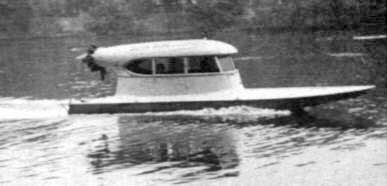
|
Above: One of the first Couzinet hydroplanes, with propeller.
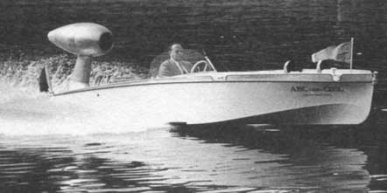
|
Above: A late Couzinet hydroplane. Money is missing, the craft is just a standard speedboat fitted with a jet engine.
In 1955, really settled in France, but without getting any government order, he gets back to his “plane-helicopter” idea of the 1920's. He wants to build a vertical takeoff craft, but with the performances of planes rather than helicopters. He registers its patent on May 25, 1955, number 1.129.038 and titled “Aerodyne with multiple wings”, patent which will be published in 1957, after his death.
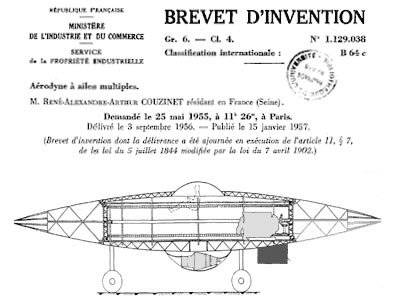
|
Above: Scan of the Couzinet “Aérodyne”, now found everywhere on the Internet.
In his workshop of the island of La Jatte in Levallois-Perret, he builds a wood and steel 3/5 scale model, not intended to fly, of “Aerodyne with multiple wings RC 360”, a craft in the shape of flying saucer which would prompt “webufologists” fantasies decades later. He shows the model in his La Jatte workshop, and in aeronautical meetings from July 1955 on, including the international aeronautical fair of Brighton in England.
Why such a flying saucer? Because the previous year, the entire France was seeing flying saucers. But it is doubtful that Couzinet believed in these flying saucers stories, he said he wanted to build what the imagination of his fellow-citizens had foreseen. It is said that he did not like that his aerodyne is called a “flying saucer” by the media.
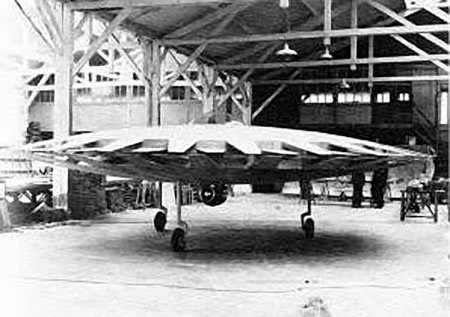
|
Above: The Couzinet aerodyne model, in the workshop.
The craft was supposed to be able to take off vertically and then fly like a jet plane. It was thus planned to be fitted, around a motionless cockpit, with six 180 HP Lycoming engines in three pairs that were supposed to make two contrarotating crowns of 96 small wings rotate, at the circumference of the craft. A 135 HP Marcel Dassault Viper with 745 kg thrust - thus wasting the saucer shape - was mounted below the cockpit for horizontal propulsion.
But his “flying saucer” obviously never flew, it was never built. The administration of aeronautics had rightly estimated that the unrealizable project would be only a waste of taxpayer's money. It did not deter the sensationalist press of 1955-1956 to making headlines with “the French Flying saucer”.

|
Above: The model of the Couzinet aerodyne, at the workshop. Note the plexiglass cockpit, and the jet engine atatched to the underside.
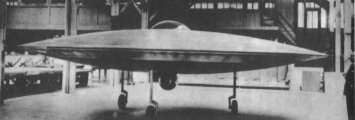
|
Above: The same photograph, uncropped, shows couzinet near the saucer model.
Moreover, three years earlier, the Anglo-Canadian ones had tried a similar project, more seriously funded: Robert Frost's Avrocar. It went far beyond building a wood model. But all the efforts remained vain. Far from taking off and darting away in the sky at the expected supersonic speed, Avrocar could hardly do better than clumsily hover less than one meter above the ground at 45 km/h, getting damaged as soon as it was “flown” over a non-flat terrain. Avrocar did not behave like a plane at all, but merely like a very ill-conceived hovercraft, missing the “skirt” true hovercrafts later used to trap an “air cushion” that enabled them to hover without much contact above the ground or water. And although some ufologists or conspirationists believe or want to make believe that this project was a big secret then, it a secret only for a few months, and the aeronautical authorities in France were not unaware of the project's failure and could only see that René Couzinet had no new solution at all.
But the media, of course, fell in love with the new saucer.
The Libération newspaper of July 2-3, 1955, who saw the pictures of the saucer model in the workshop of Levallois-Perret, writes that it is “a true revolution in aeronautical history.” Paris-Match, in 1956 [ pm1 ], shows the saucer model and other smaller Couzinet saucer models as the “French flying saucer”, a “success” needing only a few additional months of development to fly. Not only “the flying saucer exists”, but it will “soon will replace airplanes”, and “a model will fly before the end of the year. The final saucer, ten times larger, is planned for 2 pilots and 6 people. Its impressive wooden model is ready. Couzinet, who received no help so far, will build it in nine months.” And in his introduction, the writer claims that the magazine shows the “Aerodyne RC 360” for the first time, as if unveiling a big secret, although the official and public presentation took place one year earlier.
A photograph of a circular 1 meter diameter model surmounted by smoke is published as proof that “the saucer tends to go up” because its “higher rotor... sucks smoke”. Decades later a writer on the web, although being a Couzinet admirer, comments with cruel but truthful irony that his vacuum cleaner will also fly soon, for it also sucks smoke...
The new sensation reached the foreign Press as soon as 1955, with for example the newspaper Philadelphia Inquirer for July 5, 1955, in the USA, or Popular Science in the USA, headlining “Giant Pie Cooked Up By Frenchman is Latest Flying Saucer” [ps1], or Aeroplane And Commercial Aviation News, who sees in 1955 a “promising” side in Couzinet's saucer. It is shown in Flying magazine in 1955, in Naval Aviation News in 1956; Life magazine for June 18, 1956, publishes a sketch of the saucer in flight captioned “It takes off vertically”, without specifying that it is merely hoped to take off vertically if it is ever built successfully.
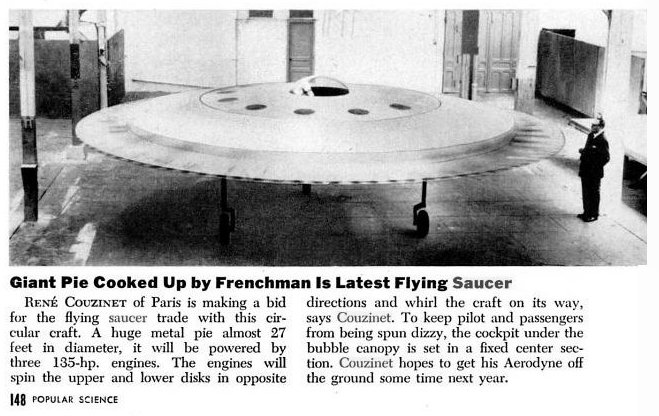
|
Above: The Couzinet saucer in Popular Science in 1955. Readers are told that Couzinet hopes to get his Aerodyne to take off in the next year, and it is not specified that the photographed thing is only a wooden model not intended to fly.
So much for a so-called “secret” of the French saucer...
Expectedly, it reaches the ufological literature, with an article by the editor of the British Flying Saucer Review, Derek Dempster, in September 1955 [ fs1 ].
But Couzinet is drowning in debts, and dramatically disillusioned as his lasted inventions convinced nobody.
On Sunday, December 16, 1956, he gets a revolver, assassinates his wife Gilberte Chazotte, widow of Jean Mermoz, then commits suicide. René Couzinet rests in the cemetery of Bagneux, in Montrouge, in the Pas-de-Calais, France.
Since the 1950's, some ufologists claim that “UFOs” and other “flying saucers” certainly do not come from other planets, but from our own: they claim “Nazi” invented them, and would still have them fly around, launched from “secret bases” located at the liking of imaginations, generally in Greenland or in the Antarctic. I already showed how these twaddles appeared and persist, but the Couzinet saucer too, was used as evidence or proof of the reality of Nazi saucers.
One finds for example in 1978, in good place in La Revue des Soucoupes Volantes edited by Michel Moutet [sv1], a photograph of an alleged supersonic “Nazi saucer” which is actually one of the photographs of Couzinet's saucer model, cropped so that its French inventor is no more on the picture. The hoax was exposed by ufologist Gilles Durant in 1984. [gd1]

|
Above: On July 4, 1955, the Var-Matin - Républisue newspaper headlined “This saucer exists” and published, like many other daily newspapers, an Associated Press photograph of the saucer model with René Couzinet standing next to it. It is this picture that would be cropped to make it a “Nazi saucer” (Below).
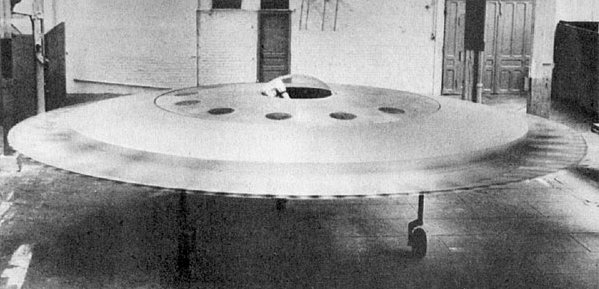
|
Above: Couzinet saucer with Couzinet cropped out.
It is claimed on the Internet that the same photography appeared in Le Fana de l'Aviation magazine (N 353, pp 53-56) in April 1999, where the “new” photograph is allegedly shown as an “unknown picture of a German V7 or V10” saucer. But that is false, the article by Gérard Bousquet is headlined “René Couzinet's flying saucer” and tells amongst other things that “in 1956, René Couzinet designed an aircraft of lenticular shape that nobody wanted but UFO buffs seized on it, making a flying saucer of it, even before the tragic death of its inventor”.
In reality, the next step for Couzinet had been to build a much smaller wood-only model. As of the “improvement” of what remained but a dream, they match those planned for the unsuccessful Avrocar: as nothing decent had been initially planned to maneuver the craft, the pure circular shape is abandoned, rudders are added... (Below). So much for the perfect saucer shape, it little by little changes into a plane!
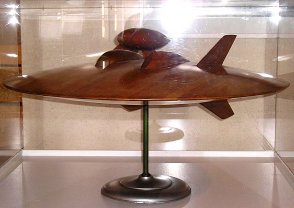
|
Above: Small wooden model for wind tunnel tests for a new Couzinet saucer concept, showed in his hometown La Roche-sur-Yon.
as of the parallel evolution, one recalls that the german worked for the us and france and russia after world ar 2 and that before that war so wel before the existence of nasa existed french antigravitation projects including partial patents before the usa get bak to the topic thereafter René Couzinet and the others are only the visible part of what was and it is very complicated to find information on these topics
(Seen on the UFO/conpiracy web forum “OVNI-USA”)
According to Henry Stevens, Couzinet died in a sudden auto accident shortly after his story and the above photos appeared in the Philadelphia Inquirer [...]
(Seen on the xenophilia.com forum)
In the fifties René Couzinet built futuristic flying saucers. Couzinet's life ended tragically.
(On a German web forum)
Another “UFO” website ensures that in his book “Les Chemins qui menaient à Rawa-Ruska”, on page 9, author Paul Chevallier said he discovered “a Flying saucer at the Renault factories”, in fact: the author, working at the Renault car factories in 1957, heard someone tell him that two workmen of the Couzinet workshops satisfied his curiosity by showing what was under a blanket at the Couzinet workshops, near Renault's factories in Levallois-Perret, showing him a model of the Couzinet saucer obviously, and not a real flying saucer in a Renault workshop. [re1]
The woo-wooing continues in 2009 in the French magazine “Top Secret” [ts1].
The author, signing “the editors”, claims that in 1956, following the 1954 French saucers flap, the French press treated the “flying saucers” French magazine Top Secret with “serious...”, “without scoffing, without irony” - this should have been nuanced at the very least. It is the 1956 Paris-Match article [pm1] that gets the honors of the article, one claims that as time went by, one must see “in what this file can trouble us nowadays”.
the author is impressed by the size “of the prototype of the flying saucer which fills the surface of a hangar”, then, most seriously we get the claim:
“The prototype is well advanced since one sees all kinds of lights there, and it seems to be rotating if one believes the effect of transparency at the level of the external blades.”
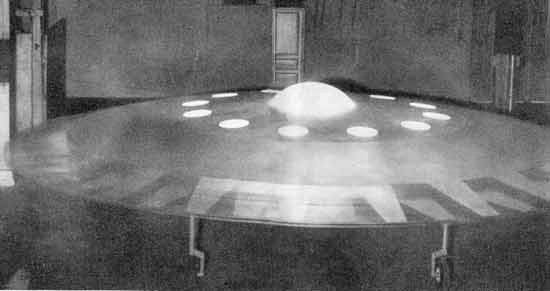
|
Above: The magazine shows a grossly faked photograph of the Couzinet saucer model: not only the photograph is the one that was cropped to remove René Couzinet, but the plexiglass cockpit and the air intakes became luminous!
Yes! On the basis of a fake picture, what was just a wooden model becomes a “prototype”, complete with science-fiction lights...
With a frown, the author quotes Paris Match as saying that a model will fly before the end of the year, that the final saucer will be ten times larger. And some thinking is offered: Couzinet cannot be a crackpot, because he is one of the great names of aviation. He id confident in the saucer's success, this means that he must have solved all the problems.
He did not get any official support. So, is this a sign that the model had no chance to result in a true flying saucer? Of course not, it is evidence of some mischievous conspiracy:
“Today, with the absence of this flying saucer in the sky, the most important question is: why didn't France give the means to this man who on many occasions had already shown his genius? t is a one more mystery and answering it is frightening...”
Whoo whoo!
Paris-Match said it was “the first saucer in the world”. “Not so sure”, Top Secret answers, as “Nazi saucers” fantasies already popped in the magazine.
Then, the author goes wild. The French craft is “in the image of a French design”, whereas “the rough lines of Nazi saucer, of Adamski type” is “of a curiously decidedly German design”. There never was a Nazi saucer, Adamski, the friend of beautiful Venusian ladies, was only a rather ridiculous liar, but it does not matter, “it is puzzling”, we are told. “While the question can hurt, it however deserves to be asked”. Ready-made cliché sentences, meaningless, obligatory in this kind of publications, obligatory in the conspirationists lectures. No, whether “these questions” hurt or not is not the issue, and yes, they were asked and asked and asked, and the detailed answers were made, and of course systematically ignored by these people who claim to “reveal the truth”: no, never did a Nazi flying saucer, nor a US flying saucer, nor a French flying saucer, fly in the skies. The only piloted terrestrial saucer to have left the ground is Paul Moller's (www.moller.com). The rest is only credulous stupidities, a taste for the mystery, pure and simple frauds and major incompetence.
The rest is no better. Couzinet “might have been a threat for the guardians of the secret”. Quite mysterious secret, a secret left to the reader's imagination, “guardians” never identified of a “secret” made of hot air... Couzinet commits suicide. The avid reader might believe it was not a suicide, for “finally, the true prowess of the guardians of the herd, is to have make it believable in the public opinion that this kind of death was normal”. Couzinet's invention is not just the construction of a wooden saucer model, it becomes a “hot” invention, “not intended for everyone but reserved only to an elite?” While “debunkers” gave up the old trick of the “secret craft” supposed to “explain” flying saucers, these secret machines which never existed, or at least never flew, and were never secret for long, never really revolutionary, but for conspirationists, the world is secretly directed by “elites”, “guardians”, they fly “Adamski saucers”. Are you in doubt about it? Well, that's because you are part of the herd, you are blind, frightened, a sheep whose brain is controlled by the “elites”, you refuse to open your eyes to the “Truths” that “we all need” and are readily available to you, for a mere 6.50 Euros in the French supermarkets, right under the nose of the “guardians” although they are ready to kill to keep yourself in ignorance...
Those who do not believe in Nazi saucers, must be the “invisible powers” who use “overmediatized counterexamples like the doubtful Avrocar, convinced that the flying discs were a dream.” That the “doubtful Avrocar” at least was a prototype, not just a wood model, that it at least hovered a few feet above the ground whereas the Couzinet saucer was just a lifeless hull does not disturb the author one bit. That you might think of an extraterrestrial origin for some of the reported UFO sightings, without believing all the Nazi saucers crap, is not even considered by the author, or meets the usual sillier answer: the aliens showed the Nazis how to build “Adamski saucers” and those “V7”, “Vril”, “Haunebu” which illustrated the neo-Nazi magazines in the 1950's... for lack of furrowing the skies.
Then, a U-turn. Couzinet had just allegedly died in “dubious circumstances”, when finally we learn he did commit suicide. Why? Because those who dreamed to build flying saucer could be only be seen as “lunatics to lock in the asylum”, and “from lunatics, they quickly become depressive and commit suicide.” In all that, neither evidence, neither information, neither logic, nor even coherence. A faked photograph, fantasies, agitation of so-called “frightening questions” and “secrets” which make only die-hard Nazi saucers buffs shiver, those who drowned in “New World Order”, “Yellow Book Number 5”, “Hollow Earth” secret Nazi bases at the North or South Pole, and other “Illuminati” in flying saucers...

|
Above: Need for truth, or need to dream? Which “truth” do we get there about the “French flying saucer”?
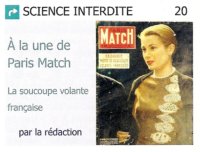
|
No, there is no “Science” in here, and really nothing “forbidden” either.

|
Why didn't France help Couzinet with his saucer project? Good question! But the magazine's response, “because his saucer was reserved for the elites”, is ridiculous. Good answer: because it was not likely to fly at all, because it was not an invention, it was not incredible but not feasible, it had been tried unsucessfully already, because René Couzinet had unfortunately started to daydream, because the solution for vertical takeoff was not to try to make a disc fly, but helicopter and VTOL planes to come.
Top Secret serves us Couzinet again in a later issue [ ts2 ] by allusions to the Couzinet saucer in connection with a flying saucer sighting story in Mertrud in... 1954... which alas was only a hoax [me1].
Nazi saucer buffs of course use the Couzinet story too. Initially, most of them didn't change it into a “Nazi saucer”, correctly informing that the thing is French and that its promoter is René Couzinet, but... nonsense is not missing.
For example, J. Andreas Epp, the so-called “German engineer Andreas Epp” who “created three spinning tops which flew respectively in 1943 and 1944”, Nazi saucer buffs claim, in his book [ ep1 ], in addition to a claim that the Couzinet suicide “remained unexplained”, invents that...
“The Couzinet flying saucer reached an anemometric speed of 600 km/h during its first test flights with a total weight of 1260 kg and an engine performance of approximately 5,66 kg...”
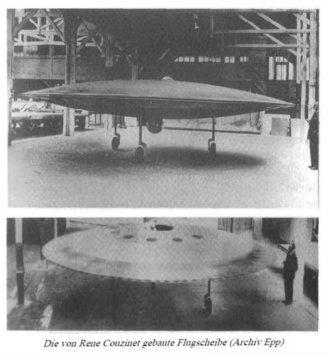
|
At least J. Andreas Epp it did not publish doctored photographs of the Couzinet Aerodyne. He used two Associated Press photographs, without cropping the French inventor out. The craft is nevertheless introduced as a flying saucer, nothing informs it was just a model, unable to fly.
And, of course, conspirationists utter sinister innuendos about René Couzinet's suicide, a death presented as “equivocal”, which is supposed to put in the readers' minds some murder by some unspecified occult powers for some reason left to the imagination...